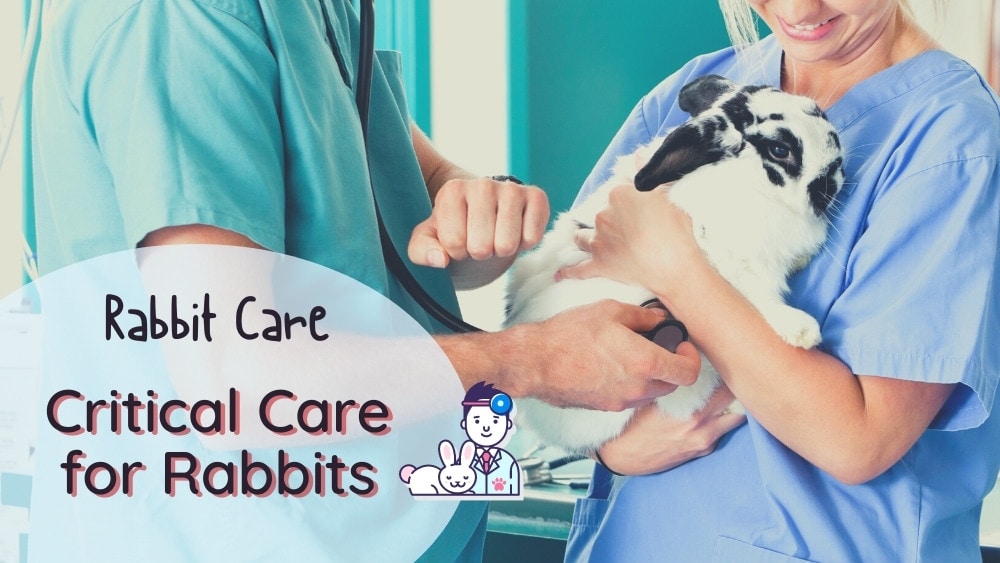Nothing scares a pet owner more than their pet rabbit getting sick! This fear multiplies when rabbits go into a critical state. It is easy to panic when the vet starts explaining about possible causes, and daunting treatments, all while seeing your pet’s health deteriorating.
Try to remain calm. The first thing to do is find out exactly what is going on with your pet with the help of a vet. Perhaps critical care will come into the picture, but we will walk you through it in this article.
We will discuss:
- What is rabbit critical care?
- What treatments are available?
- What can you do as an owner?
Hop on and read the most important points about rabbit critical care!
What is Rabbit Critical Care?
Critical care is used to support a rabbit in a life-threatening condition. As a prey species, rabbits tend to hide signs of illness and can be in a critical state by the time we realize they are sick. Rabbit critical care involves getting a diagnosis from a vet, providing fluids and nutritional support, and administering any medicines prescribed for your bunny.
6 Steps to Care For a Critically Ill Rabbit
The goal of critical care is to determine the root cause of the illness, provide appropriate treatment, avoid further advancement of the illness, and make the pet rabbit comfortable.
Critical care can be done at the hospital under the supervision of the veterinarian, or at home, provided the owner carefully follows the vet’s recommendations.
Here are the six important steps that every rabbit owner with a pet in critical condition should follow.
Step 1: Get a diagnosis from a vet
Diagnosis is the first step in caring for rabbits in critical care settings.A misdiagnosis can worsen the situation, as you don’t really know what you’re dealing with and may give the wrong treatment.
Guessing at what’s wrong with your rabbit, or even taking advice from internet resources, can never replace the professional opinion of a veterinarian who examines your rabbit directly.
There are signs of illnesses in rabbits that an owner can spot, but to make a diagnosis and know the severity of the condition, the veterinarian will have to conduct several physical tests and examinations. These might include:
- Physical examination
- Dental examination
- Blood chemistry
- Urinalysis
- Fecal analysis
- X-ray
- Ultrasound
- CT scan
These tests will help narrow down the list of possible causes of your bunny’s illness, and help the vet determine how serious the rabbit’s condition is. It will also give the vet a clear idea of what treatments or surgeries may be needed.
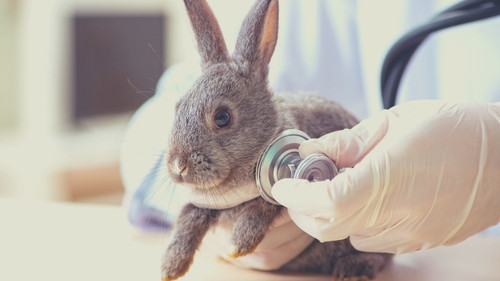
Step 2: Make a care plan
Once you know what condition your rabbit has and how severe it is, the veterinarian will devise a care plan fitting for the rabbit. Depending on your rabbit’s condition, it may require short-term, medium, or long-term critical care.
This care plan may include procedures and medications, changes to the rabbit’s diet or husbandry, and ongoing check-ups at the vet. Also, some procedures like dental work might not be appropriate while your rabbit is ill, and will need to be scheduled once they are more stable. All of these will require time, effort, and money.
If your rabbit has pet insurance, check its accredited medical facilities and how much it will cover for medical expenses such as medicines, laboratory tests, vet fees, and hospitalization expenses.
In serious cases, the rabbit might need to be admitted to the intensive care unit (ICU) of the vet hospital, particularly if they need an intravenous drip or injectable medicines. For critical cases, you should expect to be updated by the veterinary staff twice a day, and they will let you know when you can visit.
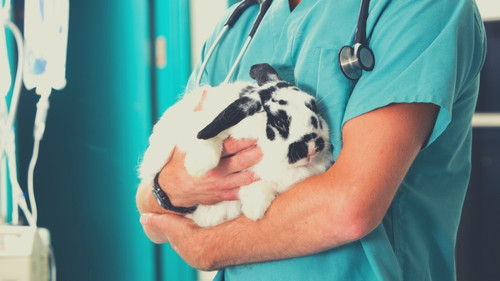
If the critically ill rabbit is at home, it will obviously require more attention than healthy pets. Owners may need to rearrange their schedules to care for the rabbit.
Step 3: Prepare your critical care materials and equipment
Pet rabbits have basic needs, but there are extra things you will need to look after a rabbit in a critical condition. These include:
- Medicines. Your vet will provide or recommend the right medications for your rabbit. These may include oral pastes or liquids, or topical creams.
- Syringe. This will be used for feeding.
- Blankets. This will provide comfort and can warm a cold rabbit. Place a warm water bottle under the blanket if your rabbit doesn’t warm quickly enough.
- Ice packs. These can help to cool down a feverish rabbit. Again, use them under cloths to cool the air around the rabbit, rather than directly onto your rabbit’s body.
- Fluids. You can use water or isotonic fluids to provide fluid support to your rabbit by mouth. Always have a bowl or bottle of fluids available, even if you are also syringe-feeding them water.
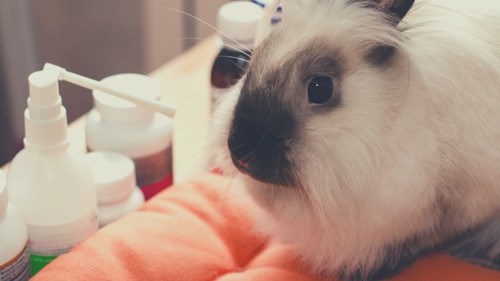
Step 4: Watch for signs of pain
Rabbits in critical condition are likely to experience extreme pain very often, and pain is detrimental to them. First, pain is always uncomfortable, and second, it will cause stress to the rabbit, which can lead to heart issues.
Pain can be detected by observing subtle changes from normal behavior. These may include changes in gait, withdrawal, scratching, abnormal posture, reduced appetite, sudden aggression, and inability to sleep well.
A veterinarian will prescribe analgesics for your rabbit’s pain if it is safe to do so. Analgesics are pain relief medications, including local anesthetics, and non-steroidal anti-inflammatory drugs (NSAIDs).
Apart from offering tender love and care, you should never devise your own homemade pain relief remedies.
Never give sick rabbits human medications or medicines prescribed to other pets, as they may be toxic for bunnies.
Step 5: Administer medicines as directed
Rabbits in critical care may need more than one kind of medicine. As an owner, you must know which is which, when to give a particular medicine, and how often.
Always follow your vet’s instructions including which medicines to give, how much, and at what times.
Administering medicines to your rabbit requires advance preparation.
- Find an assistant, if possible. Most animal procedures work better with two people, so that one can keep the animal in place and reassure them, while the other administers the medicine.
- Choose a place for the procedure, ideally on the floor, where there is enough space for you and your assistant to move.
- Lay out a towel on the floor, which you can use to place your rabbit on or wrap them in.
- Lay out your supplies, such as the medication, food or fluids, a syringe if needed, and some treats.
- Be cheerful and patient.
- Maintain a routine for the period of medication.
Most rabbit medicines are given in liquid form. If your rabbit is bright and amenable, you can try placing the liquid medicine in a dish for your rabbit to lick. Alternatively, mix it with its favorite foods or treats.
You can also suction the right amount of medicine into a syringe or eye-dropper and squeeze it into your rabbit’s mouth.
I recommend putting the tip of the syringe into the side of the mouth, behind the front teeth, and dripping the medicine slowly onto the tongue.
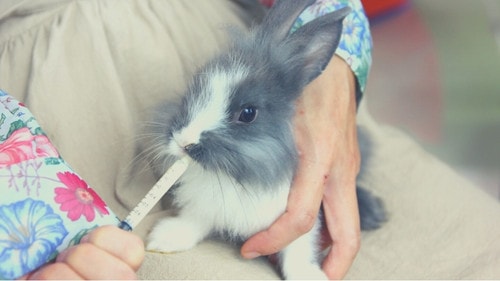
Never squirt liquid medicine, fluids or food into a rabbit’s mouth at high speed, as it can cause choking and lung infections.
Tablets are harder to give to sick rabbits, but can be administered if the rabbit is interested in food. You can insert a whole tablet into a piece of a treat, such as a bit of banana or apple, so your rabbit will swallow without realizing it. Alternatively, you can crush the pill, dissolve it in warm water, and mix it with vanilla-flavored yogurt, baby food, fresh fruit, etc.
Applying ointments, and eye and ear drops may require you to secure your rabbit firmly by wrapping it in a towel or blanket.
Ask your vet for a demonstration of the best way to administer these medicines, and make sure you have someone to help you when doing it at home.
Step 6: Provide essential food and fluids
Dehydration and gastrointestinal stasis are the biggest killers of sick rabbits, so making sure they get enough fluids and food can save your rabbit’s life. You should aim to provide all the essential nutrients through constant and consistent feeding.
Rabbits thrive on a high-fiber diet, which usually involves a large amount of grass hay, timothy hay, and small amounts of alfalfa. These foods also support proper gut physiology, encourage rabbits to eat, and provide a sense of familiarity.

However, sick rabbits often have no appetite, so you will need to find palatable foods and devise ways of force-feeding them to keep your rabbit’s digestive system ticking over. Syringe or tube feeding is applied to critically ill rabbits that cannot feed independently.
Here are some tips we use in the clinics:
- If a rabbit isn’t eating at all, you should provide a high-fiber recovery food at regular intervals. We’ll discuss this further below.
- If the rabbit is showing some interest in food, you can encourage them to eat with soft foods like apple sauce or baby cereal. The cereal can also be added to other rabbit foods to sweeten them and increase palatability. It is an excellent source of calories and is easily absorbed in the small intestine. You can also start to include a probiotic to support your rabbit’s digestive system.
- As well as hay, which should always be available, offer your bunny’s favorite greens or veggies to catch their attention. Dandelion greens are a particularly effective treat that can get a sick rabbit eating again.
- A sick rabbit needs plenty of fluids to stay hydrated. You should provide extra water or rehydration fluids, and help your pet drink as much as possible. Add a little apple, pineapple, carrot, or unsweetened vegetable juice to encourage your bunny to drink more water.

Choosing a Good Nutritional Support
If your rabbit isn’t eating, you’ll need to provide nutritional support by syringe feeding a high-quality diet. While some rabbit sites recommend mashing up your pet’s normal pellets in warm water, in veterinary clinics we usually reach for Oxbow’s Herbivore Critical Care Formula, a premium recovery food that provides essential nutrients to critically ill rabbits.

Critical Care comes in powder form, which is easy to mix into a paste or sloppy liquid, and contains high-fiber timothy hay. The herbivore version comes in apple banana flavor or aniseed flavor.
Because of the high nutritional content, it’s possible to get enough Critical Care formula into your rabbit to prevent them from developing digestive disorders. We also use it for rabbits recovering from surgery, and those who have poor nutritional status resulting from neglect.
Preparing Critical Care feed
To get your unwilling rabbit to eat Critical Care, mix one part of Oxbow Critical Care powder with two parts of warm water and stir to achieve the desired consistency.
You can refrigerate it for up to 24 hours, but it’s better to prepare fresh mixture for each feed. You also need to ensure it’s warmed up to room temperature before you feed it to your rabbit.
Syringe feeding Critical Care mixture
The process for syringe feeding Critical Care to your rabbit is as follows:
- Choose a location that is easy to clean, as this can be a messy process.
- Place your bunny facing away from you.
- Firmly hold the rabbit’s head with one hand and place the syringe in its mouth from the side, behind the front teeth.
- Slowly express the food, remove the syringe, and wait for your rabbit to swallow.
- Repeat the procedure three or four times for your rabbit to get enough.
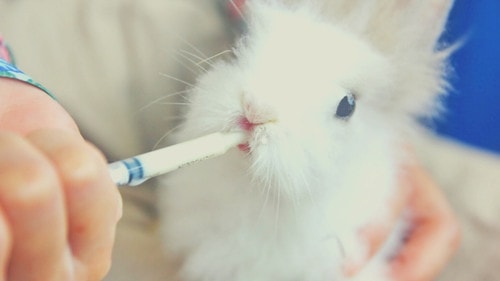
You should syringe feed your rabbit every 2 to 4 hours until it resumes eating.
Conclusion
To a lifelong rabbit owner, nothing is more important than providing his or her bunny with the best care possible, especially during a life-threatening illness and unforeseen incidents. With critical care and a vet’s guidance, you can help nurse your rabbit and possibly even save its life. Critical care involves physical, medical, and nutritional support, and although a challenging exercise, it’s worth the effort.
Did you find this article helpful? Please leave a comment and share it with fellow rabbit owners!


